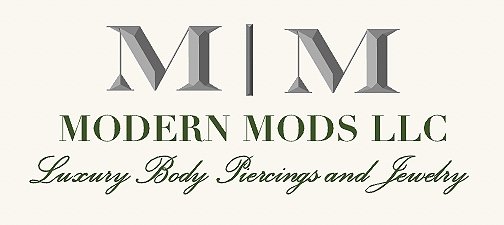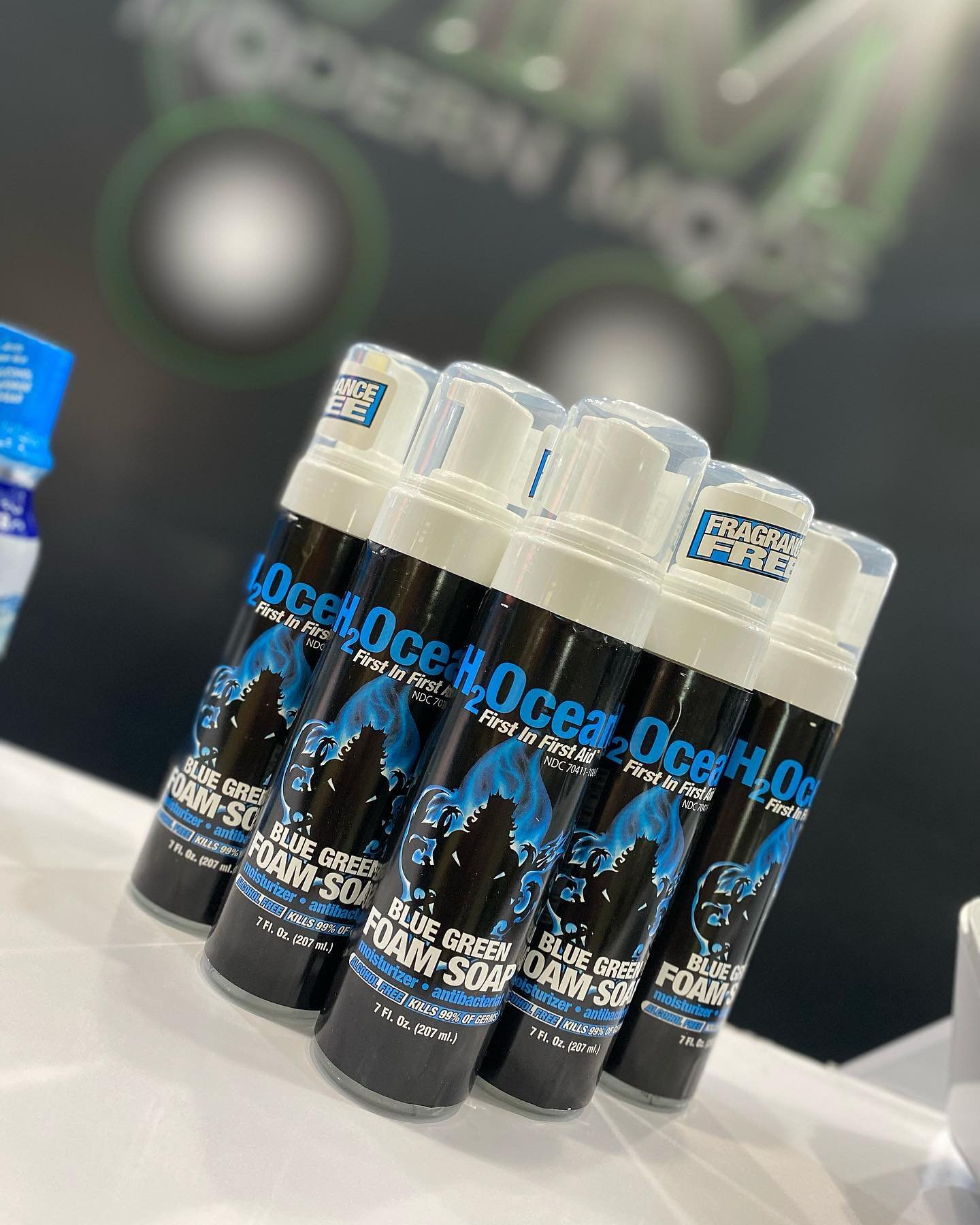
Complete aftercare for your new piercing.
For Oral Piercings:
Cleaning solutions
Use one or both of the following solutions for inside the mouth:
antimicrobial or antibacterial alcohol-free mouth rinse.
Packaged sterile saline solution with no additives or non-iodized sea salt mixture: dissolve 1/8 to 1/4 teaspoon of non-iodized sea salt into one cup of warm distilled or bottled water. A stronger mixture is not better. Saline solution that is too strong can irritate your piercing.
Cleaning instructions for inside the mouth
Rinse mouth with cleaning solution for 30 seconds after meals and at bedtime (4-5 times daily) during the entire healing period. Cleaning too often or with too strong a rinse can cause discoloration and irritation of your mouth and piercing.
Cleaning instructions for the exterior of labret(cheek/lip) piercings
Wash your hands thoroughly prior to cleaning or touching your piercing for any reason.
Saline soak for five to ten minutes once or more per day or use piercing spray sold by Modern Mods.
If your piercer suggests using soap, gently lather around the piercing and rinse as needed. Avoid using harsh soaps, or soaps with dyes, fragrances, or triclosan.
Rinse thoroughly to remove all traces of the soap from the piercing.it is not necessary to rotate the jewelry through the piercing.
Dry by gently patting with clean, disposable paper products. Cloth towels can harbor bacteria and snag on jewelry, causing injury.
What to do to help red swelling
Allow small pieces of ice to dissolve in the mouth.
Take an over the counter, non-steroidal anti-inflammatory such as ibuprofen or naproxen sodium according to package instructions. Don't speak or move your jewelry more than necessary. Sleep with your head elevated above your heart during the first few nights.
To maintain good oral hygiene
Use a new soft-bristled toothbrush and store it in a clean area away from other toothbrushes.
Brush your teeth and use your chosen rinse (saline or mouthwash) after every meal.
During healing floss daily and gently brush your teeth, tongue and jewelry.
Once healed, brush the jewelry more thoroughly to avoid plaque buildup.
Eating
Slowly eat small bites of food placed directly onto your molars.
Avoid eating spicy, salty, acidic, or hot temperature foods or beverages for a few days.
Cold foods and beverages are soothing and help reduce swelling. Foods like mashed potatoes and oatmeal are hard to eat because they stick to your mouth and jewelry.
For Body Piercings:
Cleaning solutions
Use one or both of the following solutions for healing piercings:
·Packaged sterile saline (with non-additives. Read the label) is a gentle choice for piercing aftercare. Saline for contact lenses should not be used as piercing aftercare. Wound wash saline is available as a spray at pharmacies throughout north America.
·Sea salt mixture: dissolve 1/8 to ¼ teaspoon (.75 to 142 grams) of non-iodized (iodine free) sea salt into one cup (8 oz to 142 grams of distilled or bottled water. A stronger mixture is not better; a saline solution that is too strong can irritate the piercing.
Cleaning instructions for body piercings
Wash your hands thoroughly prior to cleaning or touching your piercing for any reason.
Saline soak for five to ten minutes once or more per day. Invert a cup of warm saline solution over the area to form a vacuum. For certain piercings it may be easier to apply using clean gauze or paper towels saturated with saline solution.
If your piercer suggests using soap, gently lather around the piercing and rinse as needed. Avoid using harsh soaps, or soaps with dyes, fragrances, or triclosan.
Rinse thoroughly to remove all traces of the soap from the piercing. It is not necessary to rotate the jewelry through the piercing.
Dry by gently patting with clean, disposable paper products. Cloth towels can harbor bacteria and snag on jewelry, causing injury.
Additional Care Instructions
Wash your hands prior to touching the piercing; leave it alone except when cleaning during healing, it is not necessary to rotate your jewelry.
Stay healthy; the healthier your lifestyle, the easier it will be for your piercing to heal. Get enough sleep and eat a nutritious diet. Exercise during healing is fine; listen to your body.
Make sure your bedding is washed and changed regularly. Wear clean, comfortable, breathable clothing that protects your piercing while you are sleeping.
Showers tend to be safer than taking baths, as bathtubs can harbor bacteria. If you bathe in a tub, clean it well before each use and rinse off your piercing when you get out.

Additional Tips for Ears and Navels
Navel:
A hard, vented eye patch (sold at pharmacies) can be applied under tight clothing (such as nylon stockings) or secured using a length of Ace® bandage around the body (to avoid irritation from adhesive). This can protect the area from restrictive clothing, excess irritation. And impact during physical activities such as contact sports.
Ears:
·Use the t-shirt trick: dress your pillow in a large, clean t-shirt an turn it nightly; one clean t-shirt provides four clean surfaces for sleeping.
·Maintain cleanliness of telephones, headphones, eyeglasses, helmets hats, and anything that contacts the pierced area.
·Use caution when styling your hair and advise your stylist of a new or healing piercing.

Additional Aftercare FAQs and Facts
-
For the first three to five days: significant swelling, light bleeding, bruising, and/or tenderness.
After that: some swelling. Light secretion of a whitish yellow fluid (Not pus).
A piercing may seem healed before he healing process is complete, this is because they heal from the outside in and although it feels fine the tissue remains fragile on the inside. Be patient and keep cleaning throughout the entire healing period. Even healed piercings can shrink or close in minutes after having been there for years! This varies from person to person: if you like your piercing, keep jewelry in-do not leave the hole empty.
-
·Avoid moving jewelry in an unhealed piercing or picking away dried discharge with your fingers.
·Avoid Bactine®, pierced ear care solutions and other products containing benzalkonium chloride (BZK). These can be irritating and are not intended for long term wound care.
·Avoid over-cleaning. This can delay your healing and irritate your piercing.
·Avoid undue trauma such as friction from clothing, excessive motion of the area, playing with the jewelry, and vigorous cleaning. These activities can cause the formation of unsightly and uncomfortable scar tissue, migration, prolonged healing, and other complications.
·Avoid all oral contact, rough play, and contact with other bodily fluids on or near your piercing during healing.
·Avoid submerging the piercing in unhygienic bodies of water such as lakes, pools, hot tubs, etc.
·Avoid all beauty and personal care products on or around the piercing including cosmetics, lotions and sprays, etc.
·Don't hang charms or any object your jewelry until the piercing is fully healed.
-
·Unless there is a problem with the size, style, or material of the initial jewelry, leave it in the place for the entire healing period. See a qualified piercer to perform any jewelry change that becomes necessary during healing.
·Contact your piercer if your jewelry must be removed (such as for a medical procedure). There are non-metallic jewelry alternatives available.
·Leave jewelry in at all times. Even old or well-healed piercing can shrink or close in minutes even after having been there for years. If removed, re-insertion can be difficult or impossible.
·With clean hands or paper product, be sure to regularly check threaded ends on your jewelry for tightness. ("righty-tighty. Lefty-loosey.")
·Should you decide you no longer want the piercing, simply remove the jewelry (or have a professional piercer remove it) and continue cleaning the piercing until the hole closes. In most cases only a small mark will remain.
·In the event an infection is suspected, quality jewelry or an inert alternative should be left in place to allow for drainage of the infection. If the jewelry is removed. The surface cells can close up which can seal the infection inside the piercing channel and result in an abscess.do not remove jewelry unless instructed to by a medical professional.
Modern Mods is proudly sponsored by H2Ocean

Client Chain Care
Gold filled and sterling silver chains are built to last a long time with normal wear and tear. However, depending on outside influences on these chains, this longevity can quickly be shortened. Below are a few tips to maintain the quality of your chain:
*Minimize the exposure of chemical of any kind to the chain.
*Avoid self tanners as these may stain the chain (mainly enamel & sterling silver chains).
*Use warm water with dish soap to wash/clean the chain
*Use Goddards cleaning solution to clean sterling silver chains.
Additional Tips:
*Exposing you chain to outside sources will wear it down much quicker. Sterling silver will oxidize with central air and direct sunlight.
*Keep your chains inside a plastic baggie as often as possible and throw a small piece of white chalk into the baggies with the chain. This will help eliminate any moisture, prolonging the life of your chains.
Please note that due to the inherently delicate nature of chains, we cannot guarantee the chains or connections. We are not responsible for lost or broken jewelry.
*We are always happy to help resolve any issues you may have with your permanent jewelry and welcome you back anytime.

“We at Modern Mods are here for our clients long after they leave our chair. We ensure that our team is always available to answer questions & provide support throughout the entire healing process.”
- Heather Moss, CEO






